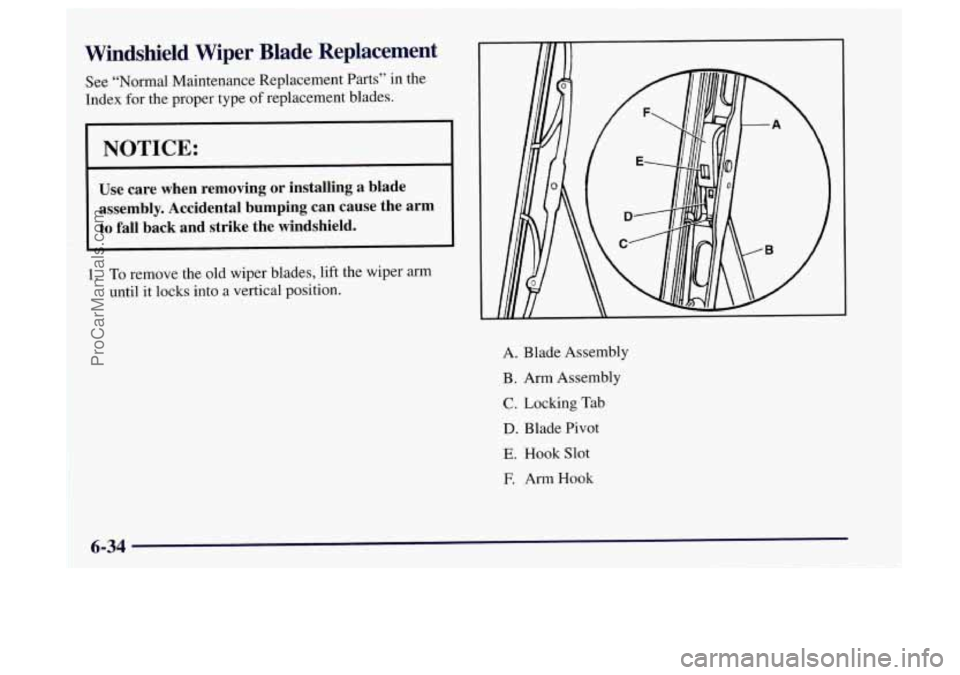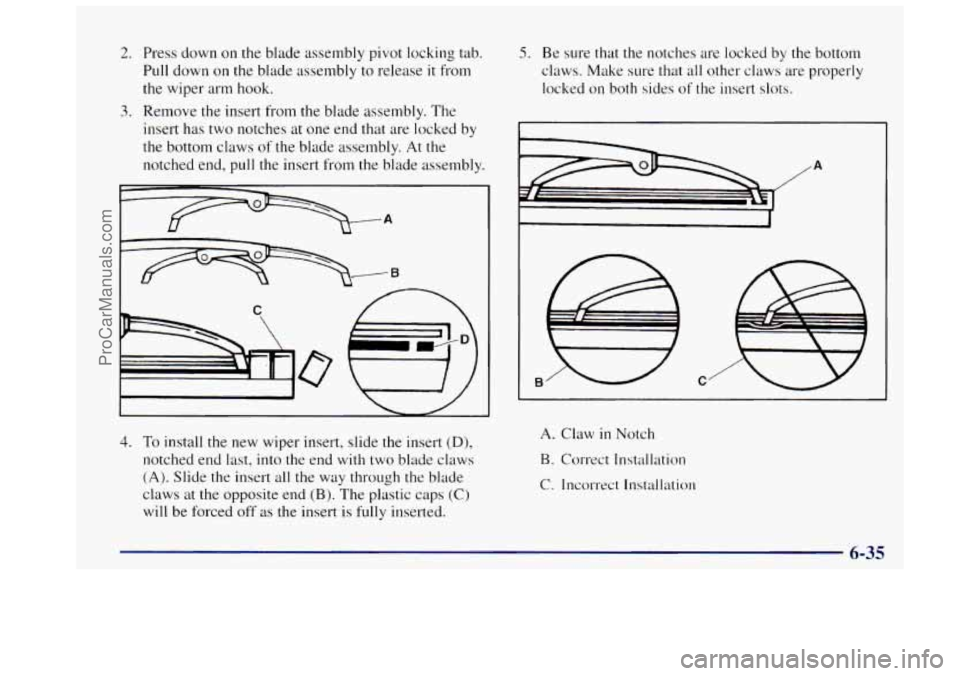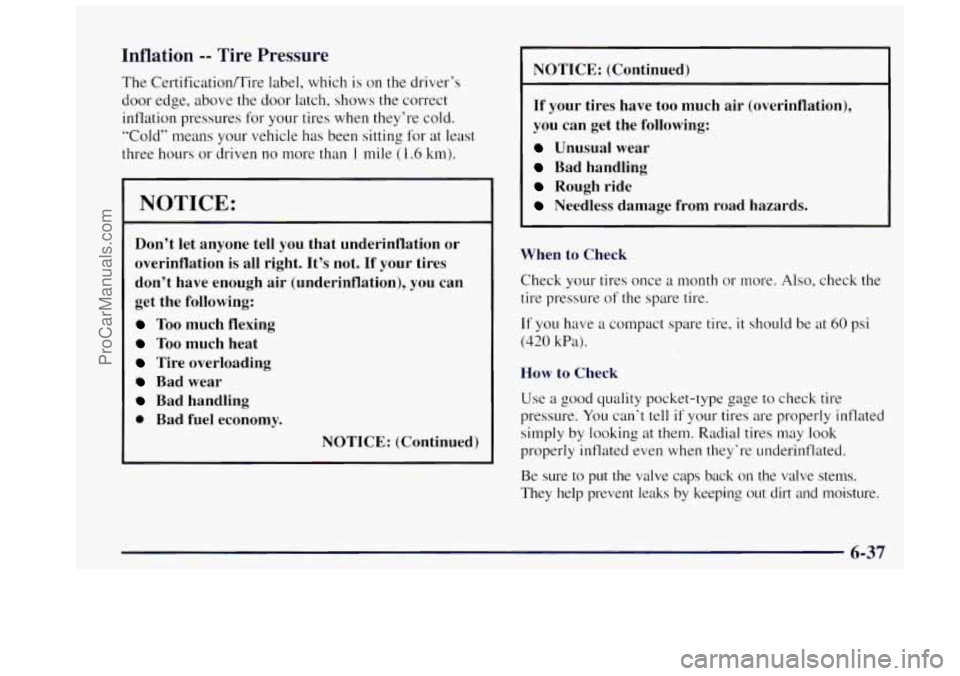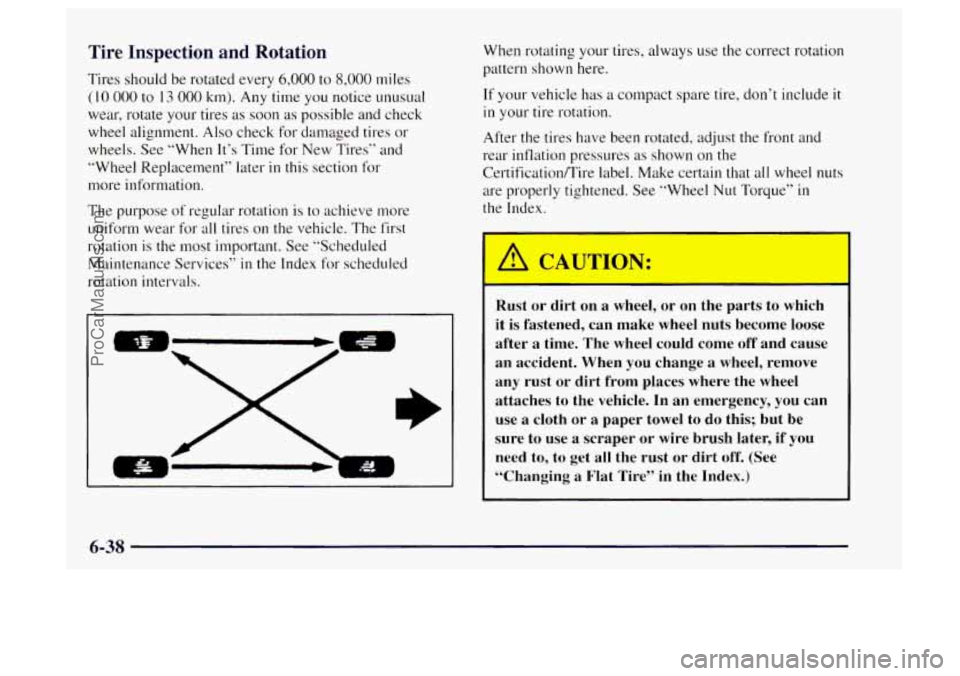OLDSMOBILE BRAVADA 1997 Owners Manual
Manufacturer: OLDSMOBILE, Model Year: 1997, Model line: BRAVADA, Model: OLDSMOBILE BRAVADA 1997Pages: 358, PDF Size: 18.02 MB
Page 251 of 358

5. Turn the bulb
counterclockwise to
remove it.
6. Put the new bulb into the headlarnp lens assembly
and turn
it clockwise until it is tight.
7. Plug in the electrical connector.
8. Put the headlamp lens assembly back into the
vehicle. Install and tighten the screws.
Front Turn Signal Lamps
1. Remove the headlamp assembly.
2. Reach down and behind the turn signal
lamp assembly.
3. Turn the socket counterclockwise and pull it out.
4. Holding the base of the bulb, pull the bulb straight
out
of the socket.
5. Push the new bulb into the socket until it clicks.
6. Put the socket back into the turn signal lamp assembly
and
turn it clockwise until it locks into place.
6-31
ProCarManuals.com
Page 252 of 358

Center High-Mounted Stoplamp
1. Remove the two screws.
2. Pull the lamp assembly out.
3. Turn the socket counterclockwise and pull it out.
4. Holding the base of the bulb, pull the bulb straight
out
of the socket.
5. Reverse the steps to install a new bulb.
Taillamps
1. Open the endgate.
2. Remove the two screws
from the lamp assembly.
4.
5.
6.
7.
8.
9.
Turn the socket counterclockwise to remove it. Push
the tab
in while you turn the socket
counterclockwise.
Holding the base
of the bulb, pull the bulb straight
out
of the socket.
Push the new bulb straight into the socket until it clicks.
Put the socket into the lamp assembly and turn the
socket clockwise
until it locks into place.
Install the lamp assembly and screws.
Close the endgate.
Underhood Lamp
1. Disconnect the electrical connector from the
underhood lamp assembly.
2. Remove the screws.
3. Disconnect the ground wire.
4. Remove the lamp assembly from the hood.
5. Install the new bulb.
6. Replace the assembly. Install and tighten the screws.
7. Connect the ground wire.
8. Connect the electrical connector to the lamp assembly.
3. Pull the assembly away from the vehicle.
6-32
ProCarManuals.com
Page 253 of 358

Front Reading Lamps
1.
2.
3.
4.
5.
6.
7.
8.
Use a coin or small screwdriver to unscrew the
center
of the overhead console lamp lens while
pressing
in on the lamp assembly.
Remove the lamp assembly from the console.
Remove the bulb assembly from the lamp assembly.
Pull the bulb straight out
of the base.
Put a new bulb into the bulb base.
Install the bulb assembly into the lamp assembly.
Place the lamp assembly into the console, turning
it
to latch it into place.
Install the lens.
Vanity Mirror Lamps
1. Insert the blade of a small screwdriver into the center
slot at the bottom of the lens.
2. Gently pry the screwdriver down in order to lift out
the lens.
3. Pry out the bulb.
4. Press the new bulb into place.
5. Slide the side tabs of the lens under the side of the
vanity assembly frame.
6. Rotate the lens downward.
7. Snap the lens into the frame.
6-33
ProCarManuals.com
Page 254 of 358

Windshield Wiper Blade Replacement
See “Normal Maintenance Replacement Parts” in the
Index for the proper type of replacement blades.
NOTICE:
Use care when removing or installing a blade
assembly. Accidental bumping can cause the arm
to fall back and strike the windshield.
1. To remove the old wiper blades, lift the wiper arm
until it locks into a vertical position.
A. Blade Assembly
B. Arm Assembly
C. Locking Tab
D. Blade Pivot
E. Hook Slot
E Arm Hook
6-34
ProCarManuals.com
Page 255 of 358

2. Press down on the blade assembly pivot locking tab.
Pull down on the blade assembly to release
it from
the wiper arm hook.
insert has two notches at one end that are locked by
the bottom claws
of the blade assembly. At the
notched end, pull the insert from
the blade assembly.
3. Remove the insert from the blade assembly. The
5. Be sure that the notches are locked by the bottom
claws. Make sure that
all other claws are properly
locked on both sides
of the insert slots.
A
4. To install the new wiper insert, slide the insert (D),
notched end last, into the end with two blade claws
(A). Slide the insert all the way through the blade
claws at the opposite end
(B). The plastic caps (C)
will be forced off as the insert is fully inserted.
A. Claw in Notch
B. Correct Installation
C. Incorrect Installation
6-35
ProCarManuals.com
Page 256 of 358

6. Put the blade assembly pivot in the wiper arm hook.
Pull
up until the pivot locking tab locks in the
hook slot.
7. Carefully lower the wiper arm and blade assembly
onto the windshield.
Backglass Wiper Blade Replacement
See “Windshield Wiper Blade Replacement” in this
section for instructions on how to change the backglass
wiper blade. The backglass wiper blade will not lock
in
a vertical position like the windshield wiper blade, so
care should be used when pulling it away from
the vehicle.
Tires
Your new Oldsmobile comes with high-quality tires
made by
a leading tire manufacturer. If you ever have
questions about your tire warranty and where to obtain
service, see your Oldsmobile Wmanty booklet
for details. Poorly maintained and improperly used tires
are dangerous.
e
0
0
0
Overloading your tires can cause
overheating as a result
of too much friction.
You could have an air-out and
a serious
accident. See “Loading Your Vehicle” in
the Index.
Underinflated tires pose the same danger as
overloaded tires. The resulting accident
could cause serious injury. Check all tires
frequently to maintain the recommended
pressure. Tire pressure should be checked
when your tires are cold.
Overinflated tires are more likely to be
cut, punctured or broken
by a sudden
impact
-- such as when you hit a pothole.
Keep tires at the recommended pressure.
Worn, old tires can cause accidents.
If your
tread is badly worn, or if your tires have
been damaged, replace them.
6-36
ProCarManuals.com
Page 257 of 358

Inflation -- Tire Pressure
The Certificationmire label, which is on the driver’s
door edge, above the door latch, shows the correct
inflation pressures for your tires when they’re cold.
“Cold” means your vehicle has been sitting for at least
three hours or driven no more than
1 mile (1.6 km).
NOTICE:
Don’t let anyone tell you that underinflation or
overinflation is all right. It’s not.
If your tires
don’t have enough
air (underinflation), you can
get the following:
Too much flexing
Too much heat
Tire overloading
Bad wear
Bad handling
0 Bad fuel economy.
NOTICE: (Continued)
I I
NOTICE: (Continued)
i If your tires have too much air (overinflation),
you can get the following:
Unusual wear
Bad handling
Rough ride
Needless damage from road hazards.
When to Check
Check your tires once
a month or more. Also, check the
tire pressure
of the spare tire.
If you have a compact spare tire, it should be at 60 psi
(420 kPa).
How
to Check
Use a
good quality pocket-type gage to check tire
pressure.
You can’t tell if your tires are properly inflated
simply by looking
at them. Radial tires may look
properly inflated even when they‘re underinflated.
Be sure
to put the valve caps back on the valve stems.
They help prevent leaks by keeping out dirt and moisture.
6-37
ProCarManuals.com
Page 258 of 358

Tire Inspection and Rotation
Tires should be rotated every 6,000 to 8,000 miles
( 10 000 to 13 000 km). Any time you notice unusual
wear, rotate your tires
as soon as possible and check
wheel alignment. Also check for damaged tires or
wheels. See “When It’s Time for New Tires” and
“Wheel Replacement” later
in this section for
more information.
The purpose of regular rotation
is to achieve more
uniform wear for all tires on the vehicle. The first
rotation
is the most important. See “Scheduled
Maintenance Services”
in the Index for scheduled
rotation intervals. When rotating your tires, always
use the correct rotation
pattern shown here.
If your vehicle has a compact spare
tire, don’t include it
in your tire rotation.
After the tires have been rotated, adjust the front and
rear inflation pressures
as shown on the
Certificationmire label. Make certain that all wheel nuts
are properly tightened. See
“Wheel Nut Toraue” in
the Index.
Rust or dirt on a wheel, or on the parts to which
it is fastened, can make wheel nuts become loose
after a time. The wheel could come off and cause
an accident. When you change a wheel, remove
any rust or dirt from places where the wheel
attaches to the vehicle. In an emergency, you can
use a cloth or a paper towel to do this; but be
sure to use a scraper or wire brush later,
if you
need to, to get all the rust or dirt off. (See
“Changing a Flat Tire” in the Index.)
6-38
ProCarManuals.com
Page 259 of 358

When It’s Time for New Tires
One way to tell when it’s
time for new tires is to
check the treadwear
indicators, which will
appear
when your tires have
only 1/16 inch (1.6 mm) or
less of tread remaining.
You need
a new tire if any of the following statements
are true:
You can see the indicators at three or more places
around the tire.
You can see cord or fabric showing through the
0 The tread or sidewall is cracked, cut or snagged deep
enough to show cord or fabric.
The tire has a bump, bulge or split.
tire’s rubber.
Buying New Tires
To
find out what kind and size of tires you need, look at
the CertificatiodTire label.
The tires installed on your vehicle when it was new had
a Tire Performance Criteria Specification (TPC Spec)
number on each tire’s sidewall. When
you get new tires,
get ones
with that same TPC Spec number. That way
your vehicle will continue
to have tires that are designed
to give proper endurance, handling, speed rating,
traction, ride and other things during normal service on your vehicle.
If your tires have an all-season tread
design, the TPC number will be followed by an
“MS”
(for mud and snow).
If
you ever replace your tires with those not having a
TPC Spec number, make sure they are the same size,
load range, speed rating and construction type (bias,
bias-belted or radial) as your original tires.
The tire has a puncture, cut or other damage that
can‘t be repaired well because of the size or location
of the damage.
ProCarManuals.com
Page 260 of 358

I
Mixing tires could cause you to lose control while
driving.
If you mix tires of different sizes or types
(radial and bias-belted tires), the vehicle may not
handle properly, and you could have
a crash.
Using tires of different sizes may also cause
damage to your vehicle.
Be sure to use the same
size and type tires on all wheels.
It’s all right to drive with your compact spare (if
you have one). It was developed for use on
your vehicle.
Uniform Tire Quality Grading
The following information relates to the system
developed by the United States National Highway
Traffic Safety Administration, which grades tires by
treadwear, traction and temperature performance. (This
applies only to vehicles sold in the United States.) The
grades are molded
on the sidewalls of most passenger
car tires. The Uniform Tire Quality Grading system does
not apply to deep tread, winter-type snow tires,
space-saver or temporary use spare tires, tires with
nominal rim diameters of
10 to 12 inches (25 to 30 cm),
or to some limited-production tires.
While the tires available on General Motors passenger
cars and light trucks may vary with respect to these
grades, they must also conform to Federal safety
requirements and additional General Motors Tire
Performance Criteria (TPC) standards.
6-40
ProCarManuals.com